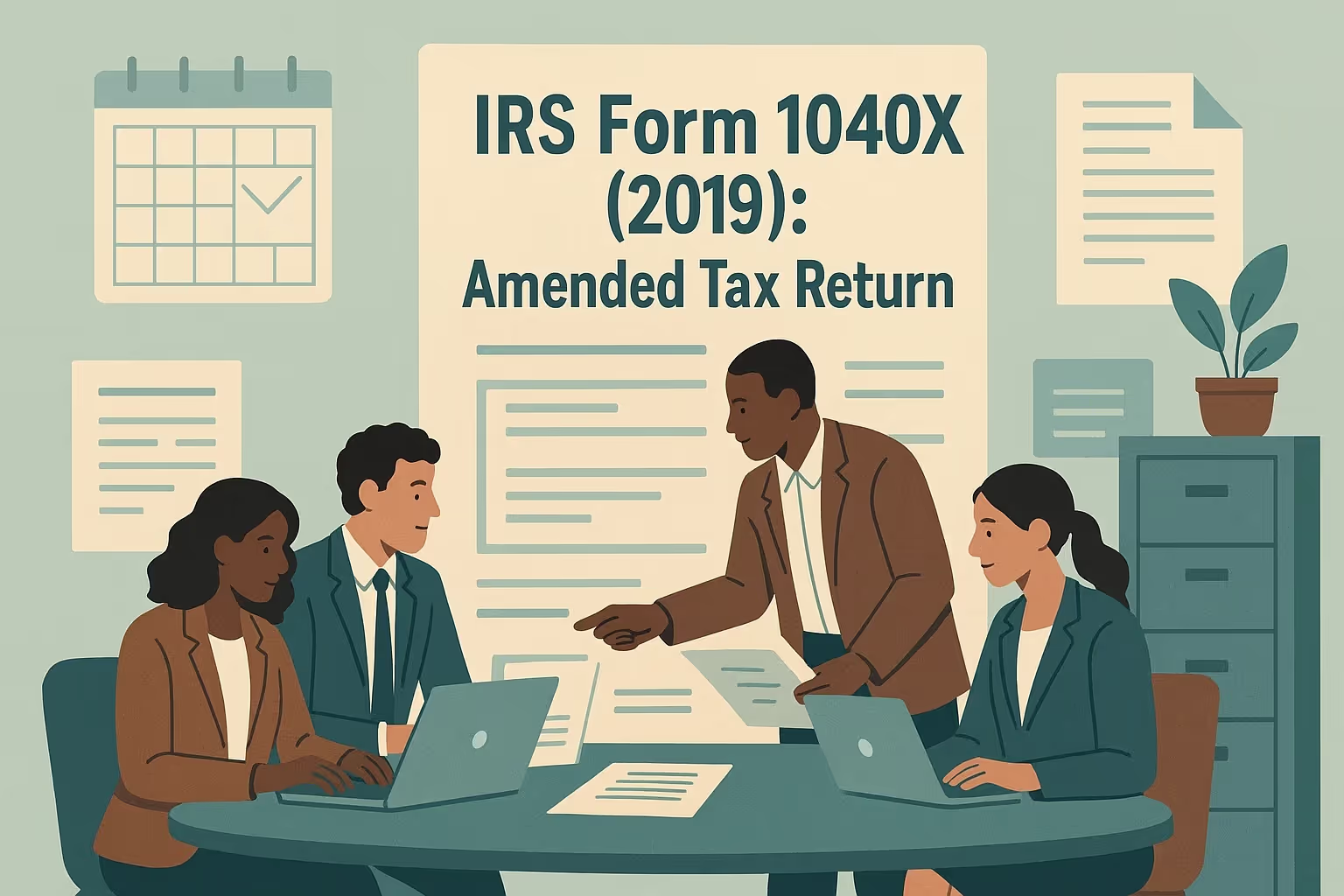IRS Form 1040X (2019): Amended Tax Return

What IRS Form 1040X (2019) Is For
IRS Form 1040X (2019) is the amended U.S. individual income tax return used to correct mistakes or make changes to a previously filed 2019 federal income tax return. Taxpayers use this form when they discover errors, missed deductions, or incorrect credits on their original return.
If you need to amend your 2019 tax year return, you may owe an additional tax payment or qualify for a refund. Amended returns for 2019 must be mailed—this version of Form 1040X cannot be electronically filed.
When to Amend Your 2019 Tax Return
You should file Form 1040X when:
- You receive corrected W-2 or 1099 forms that change your gross income or withholding.
- You find a mistake in your filing status or dependent information.
- You missed a deduction or credit that could lower your tax bill.
- The IRS sends a notice identifying discrepancies on your original return.
Refund claims must be submitted within three years of the original filing deadline or two years after the tax was paid, whichever is later. For most 2019 returns, the period expired in 2022; however, specific COVID-19 relief provisions extended the deadline to July 17, 2023.
Key Rules for the 2019 Tax Year
The 2019 tax year was the second under the Tax Cuts and Jobs Act (TCJA). Key updates included:
- Standard deductions increased to $12,200 (single), $24,400 (married filing jointly), and $18,350 (head of household).
- Personal exemptions remained eliminated.
- The child tax credit was $2,000 per qualifying dependent, with income phaseouts starting at $200,000 ($400,000 for joint filers).
- Certain business taxpayers could still carry back net operating losses, a provision later limited by the IRS.
How to Complete Form 1040X (2019)
Step 1: Gather Documents
Collect your original tax return, IRS notices, corrected W-2s or 1099s, and any related documents. Ensure that your income, deductions, and credits are accurately reflected before completing the form.
Step 2: Fill Out the Three Columns
Form 1040X uses three columns to show changes:
- Column A lists figures from your original return.
- Column B shows the net changes.
- Column C displays the corrected amounts.
Be sure each entry is accurate. Enter your Social Security number and filing date clearly to avoid processing delays.
Step 3: Explain Each Change
In Part III, explain every correction in detail. For example, note if you are adding unreported income or adjusting expenses. Clear explanations help prevent IRS audits or additional notices.
Step 4: Attach Required Schedules
Attach all affected schedules and forms, even if they have not changed. This includes any additional information that supports your amendment.
Step 5: File by Mail
Amended 2019 returns must be mailed to the IRS address listed in the form instructions. The correct address for your state is available on the IRS website. Keep proof of mailing for your records.
Step 6: Track Your Status
You can track your amended return online through the “Where’s My Amended Return?” tool on the IRS website. It may take up to three weeks after mailing for your status to appear.
Common Mistakes to Avoid
- Filing for math errors only: Don’t amend just for calculation mistakes; the IRS automatically corrects basic math errors on your original return.
- Vague explanations: Always provide precise, specific details for every change you make on Form 1040X to prevent processing delays.
- Missing documents: Attach all corrected W-2s, 1099s, and updated schedules that support your amendment.
- Incorrect column entries: Double-check that Column A matches your original return, Column B lists only the net changes, and Column C shows the corrected totals.
- Filing too early: Wait until you receive all corrected or missing documents before filing your amended return.
- Including penalties or interest: Do not add penalty or interest amounts yourself; the IRS will calculate and bill these separately if you owe additional tax.
After You File Form 1040X
Amended returns typically take eight to twelve weeks to process, although some may take up to sixteen weeks to complete. If you owe additional tax, the IRS will send a bill with payment instructions. You can pay online, by mail, or request an installment agreement using Form 9465.
If you qualify for a refund, the IRS will issue it as a paper check—direct deposit is not available for amended 2019 returns. Always include your current address and Social Security number on every form you submit.
Suppose your amendment results in additional tax, interest, and penalties that will apply from the original due date unless you show reasonable cause. If you receive a notice and disagree with the changes, you may appeal through the IRS Appeals Office.
Amending Your State Tax Return
If your federal return changes, you may also need to amend your state tax return. Many states require updated filings when your federal income or deductions change. Check your state’s tax agency website for instructions and mailing addresses.
FAQs
Can I still amend my 2019 return?
Generally, no, you cannot. The IRS limits refund claims to within three years of the original filing deadline or two years after payment, whichever is later. COVID-19 relief extended the period to July 17, 2023, for certain taxpayers.
Will I owe additional tax or penalties?
If your amendment increases your liability, the IRS will charge interest and may add penalties. You’ll receive a notice explaining the amount due and payment options.
Do I need a tax transcript before filing?
It’s not required, but obtaining your tax transcript from the IRS website helps ensure your amendment matches the IRS records.
Can I e-file my amended 2019 return?
No, the 2019 Form 1040X must be printed and mailed. E-filing is available only for tax years after 2018.
Should I wait for my refund before filing an amendment?
Yes, wait until the IRS processes your original return and issues your refund before submitting an amended return.







